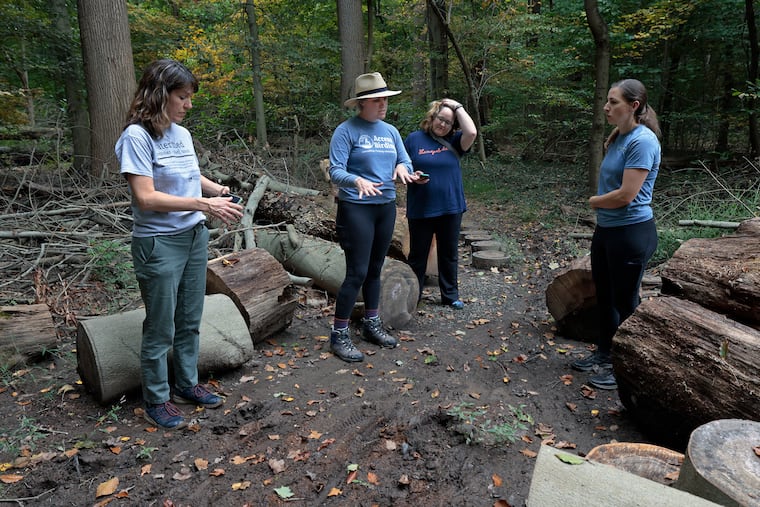A self-described ‘disabled birder’ hiked into Montco to help make the trails better for everyone
Freya McGregor, a Melbourne, Australia native, visited Montgomery County last week to assess how accessible trail systems are there.

The trail in the Armentrout Preserve meandered through the woods, crossing a gravel road and a wooden bridge before it dipped into a muddy valley where logs served as stepping-stones.
It’s an “easy” hike, according to the popular Alltrails.com app, but Freya McGregor, an Australian woman who lives in Alabama, was there with a measuring tape, notebook, and a keen eye, to give the preserve and its trails some tough love.
“Easy for whom? What’s ‘medium’? When it says a trail is ‘moderately strenuous’ is that for a marathon runner or a person in a wheelchair?” McGregor said in the preserve’s gravel parking lot Friday afternoon.
McGregor, an occupational therapist and self-described “disabled birder,” runs Access Birding, a consulting and training service. She spent a week in Montgomery County working with the nonprofit Wissahickon Trails to gauge how its trail system is experienced by people with physical disabilities, vision and hearing issues, mental illness, post-traumatic stress disorder, anxiety — even those who’ve experienced gun violence.
Wissahickon Trails, which manages 24 miles of trails in 12 Montgomery County preserves, was awarded a $70,500 grant from Montgomery County as part of the American Rescue Plan Act to improve trail accessibility. That grant will help with an assortment of improvements, including signage and kiosks, and also enabled the organization bring in McGregor.
“At the end of the day, our hope is that anyone who wants to use our trails can go on our website and figure out where they can go,” Gail Farmer, executive director of Wissahickon Trails, said at the preserve.
McGregor, 36, met with members of a Wissahickon Trails accessibility task force who all had different challenges while accessing nature, including fibromyalgia and scoliosis. At Armentrout, McGregor was joined by Farmer and Margaret Rohde, the organization’s conservation manager. Elissa Klinger, a Philadelphia resident and caregiver to her parents who use wheelchairs and supplemental oxygen, joined to describe her experience at every turn.
“This is where I would definitely have to turn around,” Klinger said by some steep steps.
Klinger said gravel, mud, steep inclines, and drop-offs, are all impediments when she’s trying to bring her mother outdoors in a typical wheelchair. She said she’d settle for benches just beyond the parking area.
“Benches are great,” McGregor said. “You can never have too many benches.”
A trail assessment by McGregor can feel daunting. She notices every rut caused by water runoff and every oversize root.
“I had to let go of my ego when she arrived and not take it personally,” Rohde joked.
Things that seem commonplace to able-bodied urban and suburban hikers stand out to McGregor.
“So this traffic noise is something I will note in my description of the trail, that there’s a portion of it that extends right next to the road. For some people that could be really uncomfortable,” she said. “Or it might be fine, but people should be able to know ahead of time.”
Among the things she’s looking for: surface type, trail width, shade, gradient, off-leash dogs, cyclists, the trail’s remoteness, and how busy it feels. Armentrout allows horseback riding but not mountain bikes.
Almost everything could be better, but McGregor said not every trail can be open to everyone.
“So knowledge is power with accessibility,” she said. “There are some trails that are never going to be 1,000% accessible. That’s not really the point of my work, though. If we can make some things better, that’s great.”
In a deep, muddy hollow, Wissahickon Trails had used sections of felled trees like stepping-stones. McGregor thought it was a great fix.
“Not all trails are going to be wheelchair-friendly, but they can be more friendly for walkers,” she said. “It’s a great solution.”
“Great,” Rohde said.
McGregor would compile her findings into a report and while Wissahickon Trails may not be able to implement all of them, immediately, Farmer hopes it can be a guidebook for years to come.
“Some of the fixes will be easy, some medium, and some more difficult to do,” she said. “We can’t do any of it if we don’t know what’s wrong to begin with.”